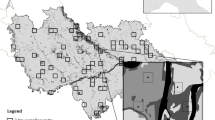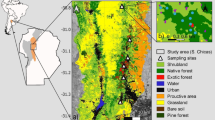Abstract
Old-growth forest birds in Fennoscandia have sharply declined in numbers during the last decades apparently due to commercial forest harvesting and fragmentation of old-growth forests. Conservation measures have led to the establishment of a forest reserve network to assure the persistence of forest birds at a regional scale. However, little is known about the effects of landscape structure within and around the reserves on the distribution of old-growth forest birds. We used a hierarchical approach to address the questions of how landscape structure and composition within forest reserves, landscape composition of surrounding areas and reserve location affect the abundance of resident, old-growth forest birds in the Northern Finnish forest reserve network. The positive role of particular landscape features on bird distribution indicates that both the proportion of old-growth forests and the structure of boreal landscape mosaic has an important role in determining the distribution of these birds. The landscape composition surrounding the reserves proved to be only a weak predictor in species distribution models, which argues against the primary role of the surrounding matrix in determining species distribution within forest reserves. Reserves located near the Russian border showed a higher abundance of old-growth birds than more western ones. Once east-west gradients in overall landscape composition had been accounted for, however, reserves did not differ significantly in the number of species present. These results suggest that landscape gradients, rather than ecological processes such as the presence of source areas located along the border with Russia, are the main determinant of the distribution of old-growth forest birds in the Finnish reserve network. We propose that to enhance regional persistence of old-growth forest birds, conservation efforts should be primarily directed towards the protection and enhancement of forest habitat quality and natural heterogeneity of landscapes within targeted areas.
Similar content being viewed by others
References
Ahti T., Hämet-Ahti L. and Jalas J. 1968. Vegetation zones and their sections in northwestern Europe. Annales Botanici Fennici 5: 169–211.
Andrén H. 1994. Effects of habitat fragmentation on birds and mammals in landscapes with different proportions of suitable habitat: a review. Oikos 71: 355–366.
Angelstam P. 1992. Conservation of communities - the importance of edges, surroundings, and landscape mosaic structure. In: Hansson L. (ed.), Ecological principles of nature conservation. Elsevier Applied Science, London, UK, pp. 9–70.
Bender D.J., Contreras T.A. and Fahrig L. 1998. Habitat loss and population decline: a meta-analysis of the patch size effect. Ecology 79: 517–533.
Buckland S.T. and Elston D.A. 1993. Empirical models for the spatial distribution of Wildlife. Journal of Applied Ecology 30: 478–495.
Chambers J.M. and Hastie T.J. 1997. Statistical models in S. Chapman & Hall, New York, New York, USA.
Crawley M.J. 1993. GLIM for ecologists. Blackwell Scientific, Oxford, UK.
Cumming S.G., Burton P.J. and Klinkenberg B. 1996. Boreal mixedwood forests may have no “representative” areas: some implications for reserve design. Ecography 19: 162–180.
Desrochers A., Hannon S., Bélisle M. and St. Clair C. 1999. Movement of songbirds in fragmented forests: can we “scale up” from behaviour to explain occupancy patterns in the landscape? In: Adams N. and Slotow R. (eds), Proc. 22 Int. Ornithol, Congress. University of Natal, Durban, South Africa.
Drapeau P., Leduc A., Giroux J.F., Savard J.P., Bergeron Y. and Vickery W. 2000. Landscape-scale disturbances and changes in bird communities of boreal mixed-wood forests. Ecological Monographs 70: 423–444.
Edenius L. and Elmberg J. 1996. Landscape level effects of modern forestry on bird communities in North Swedish boreal forests. Landscape Ecology 11: 325–338.
Esseen P.A., Ehnström B., Ericson L. and Sjöberg K. 1992. Boreal forests-the focal habitats of Fennoscandia. In: Hansson L. (ed.), Ecological principles of nature conservation. Chapman and Hall, London, UK, pp. 252–325.
Esseen P.A., Ehnström B., Ericson L. and Sjöberg K. 1997. Boreal forests. Ecological Bulletin 46: 16–47.
Fayt P. 1999. Available insect prey in bark patches selected by the Three-toed Woodpecker Picoides tridactylus prior to reproduction. Ornis Fennica 76: 135–140.
Haila Y. 1994. Preserving ecological diversity in boreal forests: ecological background, research, and management. Annales Zoologici Fennici 31: 203–217.
Haila Y. and Järvinen O. 1990. Northern conifer forests and their bird species assemblages. In: Keast A. (ed.), Biogeography and ecology of forest bird communities. SPB Academic Publishing, The Hague, The Netherlands, pp. 61–85.
Harrison S. and Bruna E. 1999. Habitat fragmentation and large-scale conservation: what do we know for sure? Ecography 22: 225–232.
Helle P. and Järvinen O. 1986. Population trends of north Finnish land birds in relation to their habitat selection and changes in forest structure. Oikos 46: 107–115.
Helle P. and Mönkkönen M. 1986. Annual fluctuations of land bird communities in different successional stages of boreal forest. Annales Zoologici Fennici 23: 269–280.
Herrera C.M. 1978. On the breeding distribution pattern of European migrant birds: MacArthur's theme re-examined. Auk 95: 496–509.
Imbeau L., Mönkkönen M. and Desrochers A. 2001. Long-term impacts of forestry on birds of the eastern Canadian boreal spruce forests: What can we learn from the Fennoscandian experience? Conservation Biology 15: 1151–1162.
Jokimäki J. and Huhta E. 1996. Effects of landscape matrix and habitat structure on a bird community in northern Finland: A multi-scale approach. Ornis Fennica 73: 97–113.
Järvinen O. and Väisänen R.A. 1975. Estimating relative densities of breeding birds by the line transect method. Oikos 26: 316–322.
Järvinen O. and Väisänen R.A. 1977. Long-term changes of the North European land bird fauna. Oikos 29: 225–228.
Järvinen O., Kuusela K. and Väisänen R.A. 1977. Effects of modern forestry on the numbers of breeding birds in Finland in 1945–1975. Silva Fennica 11: 282–294.
Kouki J. and Väänänen A. 2000. Impoverishment of resident old-growth forest bird assemblages along an isolation gradient of protected areas in eastern Finland. Ornis Fennica 77: 145–154.
Lahti K., Orell M., Rytkönen S. and Koivula K. 1998. Time and food dependence in willow tit winter survival. Ecology 79: 2904–2916.
Legendre P. and Legendre L. 1998. Numerical Ecology. Elsevier Science, Amsterdam, The Netherlands.
Lindén H., Danilov P.I., Gromtsev A.N., Helle P., Ivanter E.V. and Kurhinen J. 2000. Large-scale forest corridors to connect the taiga fauna to Fennoscandia. Wildlife Biology 6: 179–188.
McGarigal K. and Marks B.J. 1995. FRAGSTATS: spatial pattern analysis program for quantifying landscape structure. General Technical Report PNW-GTR-351. U.S. Forest Service, Portland,Oregon, USA.
Mönkkönen M. 1999. Managing Nordic boreal forest landscapes for biodiversity: ecological and economic perspectives. Biodiversity and Conservation 8: 85–99.
Mönkkönen M. and Reunanen P. 1999. On critical thresholds in landscape connectivity: a management perspective. Oikos 84: 302–305.
Mönkkönen M. and Welsh D.A. 1994. Biogeographical hypothesis on the effects of human caused habitat changes on the forest bird communities of Europe and North America. Annales Zoologici Fennici 31: 61–70.
Nilsson C. and Götmark F. 1992. Protected areas in Sweden: is natural variety adequately represented? Conservation Biology 6: 232–242.
Raivio S. and Haila Y. 1990. Bird assemblages in silvicultural habitat mosaics in southern Finland during the breeding season. Ornis Fennica 67: 73–83.
Reunanen P., Nikula A. and Mönkkönen M. 2002. Regional landscape patterns and the distribution of the Siberian flying squirrel in northern Finland. Wildlife Biology (in press).
Roldstad J. and Wegge P. 1989. Capercaillie Tetrao urogallus populations and modern forestry: a case for landscape ecological studies. Finnish Game Research 46: 43–52.
Saab V. 1999. Importance of spatial scale to habitat use by breeding birds in riparian forests: A hierarchical analysis. Ecological Applications 9: 135–151.
Schmiegelow F.K.A., Machtans C.S. and Hanon S.J. 1997. Broad-scale patterns in short term response of a boreal bird community to experimental forest fragmentation. Ecology 78: 1914–1932.
Schmiegelow F.K.A. and Mönkkönen M. 2002. Fragmentation issues in dynamic landscapes: avian perspectives from the boreal forest. Ecological Applications 12: 375–389.
Siitonen J. 2001. Forest management, coarse woody debris and saproxylic organisms: Fennoscandian boreal forests as an example. Ecological Bulletins 49: 11–41.
Sjöberg K. and Ericson L. 1997. Mosaic boreal landscapes with open and forested wetlands. Ecological Bulletins 46: 48–60.
Snow D.W. and Perrins C.M. 1998. The birds of the western Palearctic. Concise edition. Oxford University Press, xford, England.
Storaas T. and Wegge P. 1987. Nesting habitats and nest predation in capercaillie and black grouse in South East Norway. J. Wild. Manage. 51: 167–172.
Syrjänen K., Kalliola R., Puolasmaa A. and Mattson J. 1994. Landscape structure and forest dynamics in subcontinental Russian European taiga. Annales Zoologici Fennici 31: 19–34.
Tomppo E. 1993. Multi-source National Forest Inventory of Finland. In: Nyyssönen A., Poso S. and Rautala J. (eds), Proceedings of Ilvessalo Symposium on National Forest Inventories. The Finnish Forest Research Institute Research Papers., Helsinki, Finland, pp. 52–59.
Uimaniemi L., Orell M., Mönkkönen M., Jokimäki J., Huhta E. and Lumme J. 2000. Genetic diversity in the Siberian jay Perisoreus infaustus in fragmented old-growth forests of Fennoscandia. Ecography 23: 668–677.
Villard M.-A., Trzcinski M.K. and Merriam G. 1999. Fragmentation effects on forest birds: relative influence of woodland cover and configuration on landscape occupancy. Conservation Biology 13: 774–783.
Virkkala R. 1987. Effects of forest management on birds breeding in northern Finland. Annales Zoologici Fennici 24: 281–294.
Virkkala R. 1991. Population trends of forest birds in a Finnish Lapland landscape of large habitat blocks: consequences of stochastic environmental variations or regional habitat alteration? Biological Conservation 56: 223–240.
Virkkala R., Rajasärkkä A., Väisänen R., Vickholm M. and Virolainen E. 1994. The significance of protected areas for the land birds of southern Finland. Conservation Biology 8: 532–544.
Väisänen R., Järvinen O. and Rauhala P. 1986. How are extensive, human-caused habitat alterations expressed on the scale of local bird populations in boreal forests? Ornis Scandinavica 17: 282–292.
Väisänen R.A., Lammi E. and Koskimies P. 1998. Distribution, numbers and population changes of Finnish breeding birds. Finnish with English summary. Otava, Helsinki, Finland.
Author information
Authors and Affiliations
Rights and permissions
About this article
Cite this article
Brotons, L., Mönkkönen, M., Huhta, E. et al. Effects of landscape structure and forest reserve location on old-growth forest bird species in Northern Finland. Landscape Ecology 18, 377–393 (2003). https://doi.org/10.1023/A:1026148825138
Issue Date:
DOI: https://doi.org/10.1023/A:1026148825138




